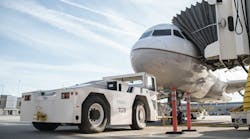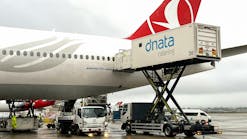Ground Handling and Low-Cost Carriers
Budget airlines (low-cost carriers and ultra-low-cost carriers) originally had a very specific model: sell the seats cheap, and keep costs low. The first one in the United States was Southwest Airlines, which in 1971, gave the industry no-frills service and at the time, one aircraft type. This was uncommon, but it also was successful and changed the way the world travels by air.
Innovata reports that in 2014, low-cost carriers (LCCs) increased their flights to more than 136,200 a week, which overran all three major airline alliances (Oneworld, SkyTeam Alliance and Star Alliance). The airline research group, a partner to International Air Transport Association (IATA) and part of Flightglobal, covers more than 800 carriers worldwide. Innovata reports that LCCs now account for 22 percent of the world’s airline capacity.
That said, Paul Berry, a representative from Spirit Airlines an ultra-low-cost-carrier (ULCC), says that these groups of airlines address ground handling needs with the same approach as their legacy counterparts.
“At Spirit, we are completely outsourced in almost all of our stations (with the exception of Fort Lauderdale-Hollywood International Airport), so we need all of the standard services including passenger service, ramp, aircraft cleaning, wheelchair assistance, fueling, etc.,” he says.
Unique challenges
The increase of LCC flights has placed pressure on ground handling service providers to record faster turnaround times than legacy airlines require. Typically, a LCC flight can be turned around in a half-hour, as there are less beverages and meals offered to passengers and not as much cleaning needs to be done between flights. Also, if on shorter routes, a long fueling process is unnecessary at each stop.
Berry says that the frequency of flights at a specific location doesn’t really change the cost of ground handling services, but it may affect the cost-cutting measures necessary to continue offering low fares.
“In stations where we have higher volumes, our cost per departure for essential services would be on-par with non-ULCC carriers,” he says. “At those stations where our flight volume is low, we could be disadvantaged on a cost per departure basis.”
The majority of LCCs are also outsourcing the ground handling services they do use. In 2015, The Denver Post published an article about Frontier’s change to outsource all ramp, baggage, gate and ticket-counter jobs at Denver International Airport (DEN) and more cuts at General Mitchell International Airport (MKE) in Milwaukee, WI. This has been a common trend throughout the industry and one that isn’t likely to change soon.
The challenges that come with this might not either.
The world perspective
An interesting study was done by a student at the Hamburg University of Applied Sciences which reviewed ground handling for low cost carriers in Asia, North America and Europe. Yik Lun Tan reported that North America and Europe have more advanced facilities overall, but that the general labor cost in Asia is lower. They also then spend more on advertising.
In North America, low-cost carriers are found at every airport, while in other parts of the world, primary airports are really the prime place to find a LCC, as the population density varies greatly from the wider-spread land areas.
The other significant impact in ground handling is the availability of Internet access to passengers. Less people are needed where most of the booking, payment, promotion and even check-ins, etc., can now be done online. It’s a cost-saving measure many airlines have implemented and in greater strides in recent years. He says the Asian markets have become more adept in this as well.
Lun Tan’s research shows that ground handling markets worldwide have opened up and are becoming more competitive, mostly in North America and Europe. Research and Markets says that a newer report they offer projects the Global Aircraft Ground Handling System Market is poised to grow at a compound annual growth rate (CAGR) of around 7.3 percent over the next decade to reach approximately $7.43 billion by 2025.
Common ground
While there are differences between legacy carriers and low-cost ones, they do share much common ground: maintaining customer service, the need to reduce costs and increase efficiency. Lower fuel costs have helped that recently, as a 34 percent decrease was recorded in the last year by Airlines for America (A4A).
Ground handlers are keeping pace by having multiple streams of revenue at a single location, and able to service more than one lower cost carrier at a time. In the Winter 2015/Spring 2016 issue of Cargo Airports & Airline Service magazine out of the United Kingdom, Mandy Dunn, communications manager for Cleveland, Ohio-based Flight Services & Systems (FSS), says that the ground service market is increasing fast, with her company anticipating 15 to 16 percent growth in coming years.
Outsourcing these services is helping the airlines stay competitive and keep that low-cost carrier status. In the Denver Post article, Frontier CEO Dave Siegel admitted that it’s difficult, but that the changes allow Frontier to grow as a company. DEN was the last airport of Frontier’s service to make the switch from in-house ground handling services and is now outsourced to Swissport USA and Sitel for reservations.
The good news is the jobs don’t disappear, but the CEO told the Post that these customized companies bring a new level of efficiency and workload management. While others disagree, airlines are tasked with keeping customers happy, airports full and also meeting their bottom lines.
“Swissport is the best airport operator in the U.S. and I would argue, in the world,” Siegel said last year. “This is their business and they are really good at it. And they are very adept at running larger operations – it’s their sweet spot.”
Keeping clients happy
Speaking of sweet spots, both ground handlers and any airlines know that it’s essential to find one and stay there as long as possible.
Berry’s advice for ground handlers?
“Do consistently good work,” he notes, and explains that Spirit Airlines boasts “outstanding relationships” with most of the current large ground handling service providers.
The competition in the industry is tight, and trying to gain ground in a new location can be a challenge. From securing office space, to a leadership team and then permits, a new workforce, much time and money goes into a start-up, Dunn relayed. She said FSS tries to find a key client, keep them happy and then build a business from there, a model which has worked well for them in the States.
Berry says Spirit is recognized by Swissport and DAL Global Services as being in the top five of all their customers. He offers this insight as well, from the ULCC perspective: “Spirit also looks for additional services providers in order to maintain a diversified portfolio. If there is a ground handling company out there that we are not familiar with, there is a chance we could find them before they approach us.”
Staffed and safe
Dunn told Cargo Airports & Airline Service that in addition to keeping clients happy, staff training is essential for recruiting and retaining high-quality employees. Airlines are also looking intently at what they can do differently to save costs, but maintain a high standard of service, especially the budget, lower-cost carriers.
EasyJet, a British low-cost carrier, said that it sources everything it can, as long as that is manageable. The same article explains that this does come with risks such as security credentialing more employees, and having to cancel flights if the ground handlers go on strike, which has happened in recent years.
EasyJet representatives say that two years ago, 20,000 people who worked for the airline in 140 airports were not on the company’s list of formal employees, but subcontractors. For some airlines, only crew and pilots are on payroll, and as the airlines grow, some things are brought in-house because of the need to close margins, such as engineering and fleet management.
The ground handling market is open for business and forcing low-cost carriers to maintain their low fares, keep pace with the decreasing fares of legacy airlines, all while providing a high level of service to both customers and staff. It’s no easy feat for any airline to maneuver.







